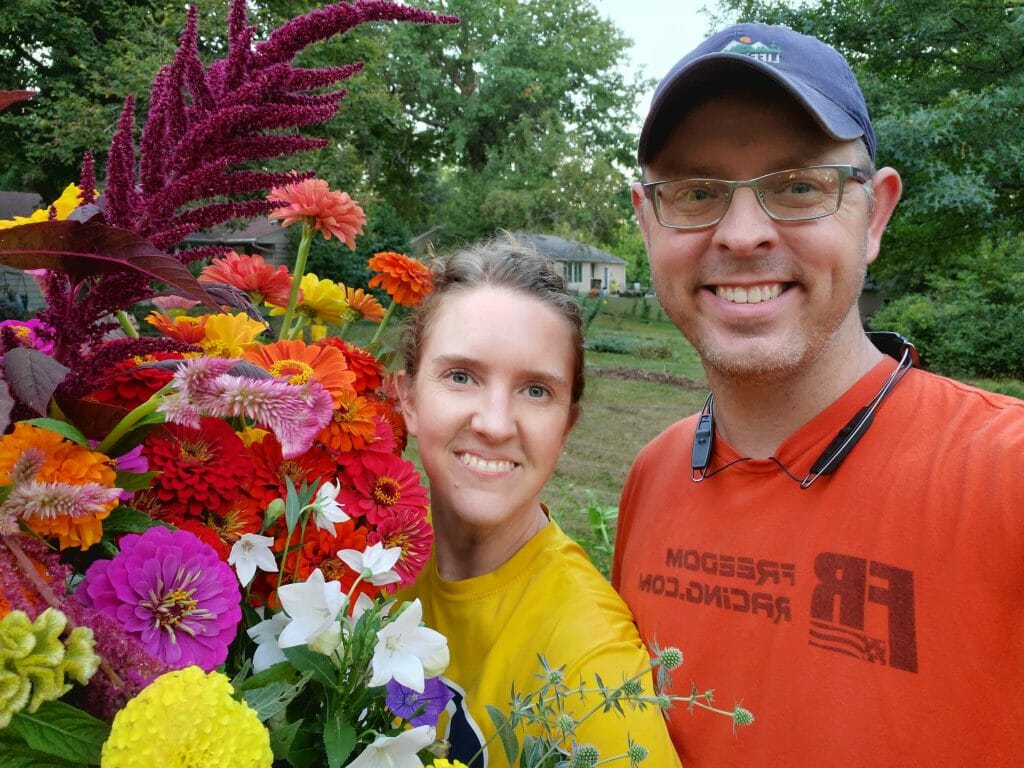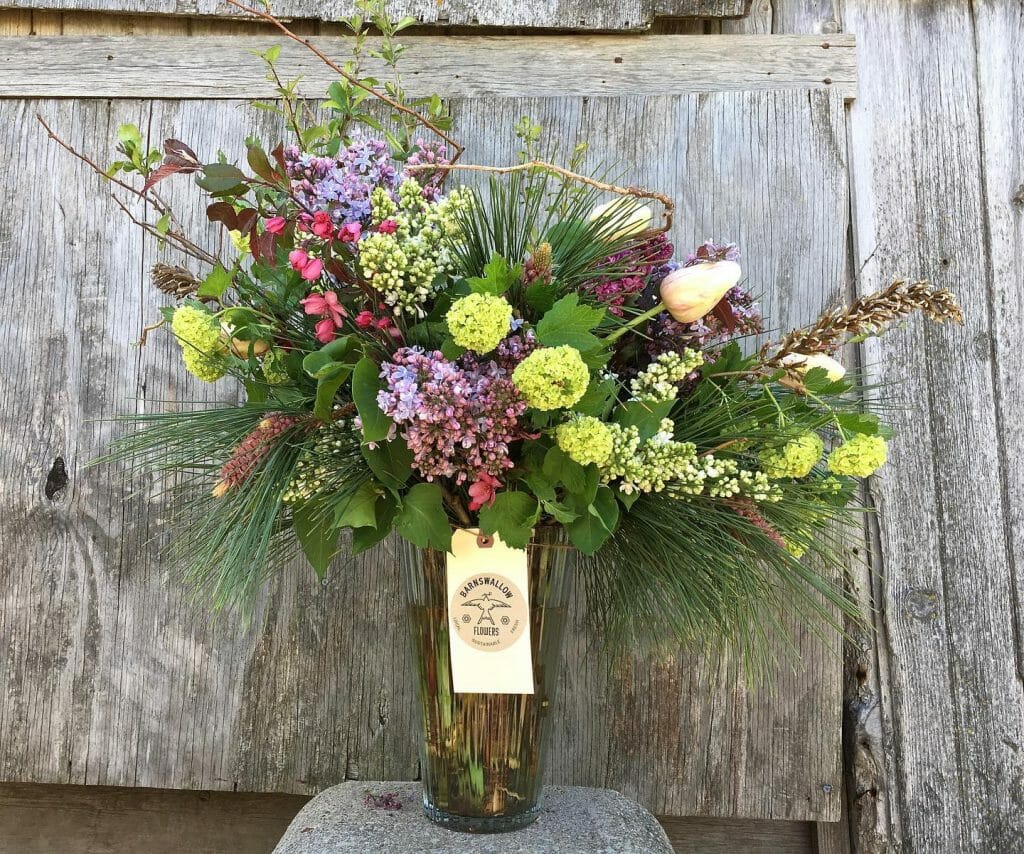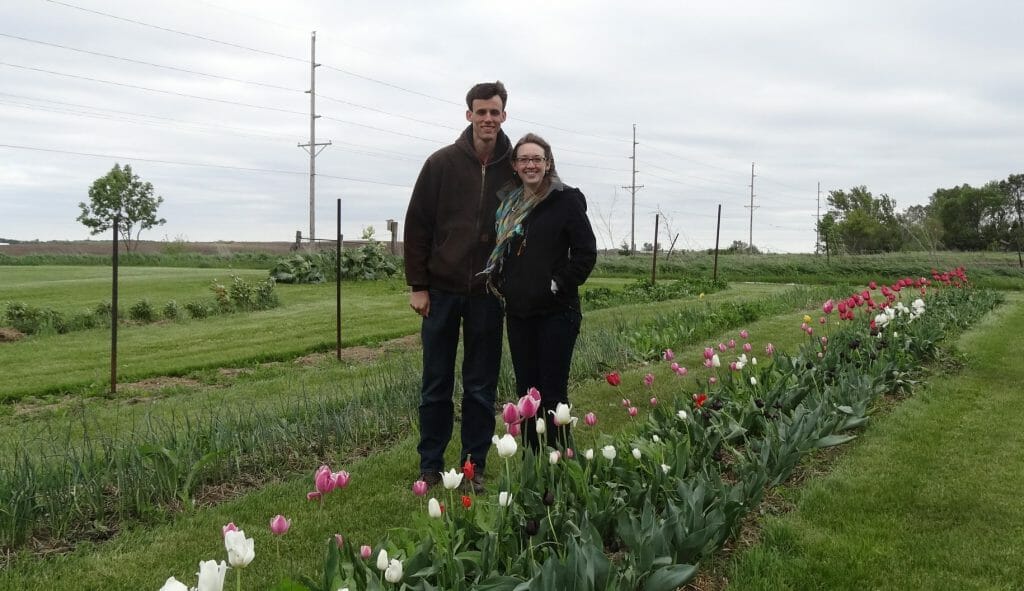The Joy of Flowers
For some members, growing flowers is about creativity, sustainability and connecting with community.
In recent years, local flowers have dazzled with their growing presence in restaurants, cafes, Main Street shops, farmers markets, and of course, on social media.
When scrolling through photos of gorgeous bouquets on social media or imagining rows of dahlias and hedges of pillowy hydrangeas, the romance stands out. But there is much more to flower farming. Cut flowers can offer flexibility, community connection, a means of sustainability and an outlet for creativity quite unlike any other crop.
Balancing Bottom Lines
Chad Hensley and Katie Hensley started Big Creek Farm in fall of 2012. They live on a lot-and-a-half in Lamoni, Iowa, with ample growing space for annual flowers, an array of perennials and flowering shrubs and trees. Of the additional 160 acres of rented farmland, roughly 1 acre is in vegetable and flower production and the rest in rotational grazing for grass-fed beef. Flowers were a big part from the beginning. Today, beef is a key focus, but when they started, the Hensleys lacked capital to get into cattle at any scale. Horticultural crops felt like a better opportunity for return on their investment.

Katie and Chad Hensley share beauty and joy with through a flower CSA at Big Creek Farm in Lamoni, Iowa.
Chad and Katie’s foundational principles were clear, though. They strive for Holistic Management, an approach that prioritizes balancing economic, environmental and self-care considerations. With this framework, and by sinking their roots into their community more deeply, the Hensleys are excited and determined to show what they can accomplish in a local economy.
Finding the right market for local flowers can be a journey. Many flower farmers find a good fit with florists, wholesalers, or both. There are also opportunities for dried flowers, individual stems and more. For a time, Chad and Katie pursued wholesale with florists in Kansas City, Missouri. Eventually, they concluded that making those trips didn’t meet holistic bottom lines that worked for them, so they stopped and pivoted to their own community.
“Flowers are good because you can stay at your own scale,” Chad says, referring to the flexibility that growing flowers afforded them.
“There is joy in watching flowers grow, develop and bloom. It is also meaningful to think about the happy and sad moments when people are receiving flowers . . . . They are worth the money even if they aren’t a necessity.” – Katie Hensley
Today, Big Creek’s main sales focus is a flower CSA. This model lets the Hensleys secure revenue at the start of the season and builds in security and flexibility. For 15 weeks, customers get either the small “nice” bouquet or the large “wow” bouquet, as Katie describes them. With the closure of Lamoni’s only florist shop three years ago, Katie has become the town florist.
In the overwhelming year that was 2020, Big Creek Farms’ flower CSA turned out to be more valuable than Chad and Katie ever expected. They discovered that the beauty and joy flowers brought people was as necessary as any other nourishment that year. As they put it, “People simply needed it.” One customer bought one flower share to keep and a second to have a bouquet to give away every week. Another customer gifted a flower share to a local nursing home, making Katie’s bouquets a consistent bright spot for staff and residents through dark days of isolation and uncertainty during the pandemic.
Chad and Katie both express a deep feeling of being of service to their community. “There is joy in watching flowers grow, develop and bloom,” Katie says. “It is also meaningful to think about the happy and sad moments when people are receiving flowers – for graduations, a miscarriage once, weddings, funerals. They are worth the money even if they aren’t a necessity.”
A Creative Way Forward
Meredith Nunnikhoven operates a flower CSA at Barnswallow Flowers & Produce, a 3-acre, diversified, sustainable farm that operates alongside her family’s commodity-based farm outside Oskaloosa, Iowa. Like the Hensleys, she is also committed to proving that the small, diversified model can work.
In choosing the best route for marketing her flowers, Meredith has tried several options, including working with wholesalers, selling directly to florists and taking part in farmers markets. She is now focused on the CSA model – though she has also found success in partnering with nearby farms that presell through online sales.

A flower arrangement created by Meredith Nunnikhoven of Barnswallow Flowers & Produce near Oskaloosa, Iowa. Flowers are part of the farm’s diversified operation. Photo courtesy of Meredith Nunnikhoven.
In addition to flowers, vegetables are a piece of the puzzle, and chestnuts will soon add another income stream as the grove matures. Meredith is a proponent of diverse income streams, including “off-farm income.” She also rents her 1940s-era farmhouse on Airbnb and will soon further expand her enterprises with valued-added products that include hot sauce and a mysterious “secret project” that she’s not ready to divulge.
But the flowers are where Meredith’s creativity, innovation, inspiration and marketing savvy reveal themselves. Similar to Big Creek Farm’s bouquets, a Barnswallow bouquet may include cultivated annuals, stems from heirloom shrubs, foraged grasses, blooms from cover crops and more surprises. Meredith draws on the full range of flora from across the property for her arrangements, resulting in dramatic botanical combinations and wildly unique bouquets.
“It’s about staying local and getting involved with the customer down the road.” – Meredith Nunnikhoven
Growing flowers also plays a role in Meredith’s focus on regenerative practices. She opts to grow plants from seed and without chemicals, fertilizing with chicken litter from a neighbor’s farm, supplementing with organic worm castings from a company based in Indianola, Iowa, and focusing on outdoor production.
She is also experimenting with raising plants that may grow well in Iowa but aren’t easy to ship. For instance, are artichokes a viable crop here? How can she best extend the life of cut lilacs? What varieties of peonies are best suited to her farm? Seeking the answers to questions like these feeds Meredith’s curiosity, expands her offerings and creates a market niche for her products, all through a quest for greater sustainability. “It’s about communicating a message through what we’re making,” Meredith says. “We’re finally getting to what aligns with our values. It’s about staying local and getting involved with the customer down the road.”
The Art of Sustainability
For Naomi Friend, sustainability is a core part of her goal with flower production. In rare cases, she has had to order from floral suppliers to have enough flowers for an off-season event. Working with these flowers, rather than ones she had grown herself, was eye-opening. “The waste in the floral industry is a lot,” she says.
“By providing an alternative product, I’m serving customers who share my values of chemical-free methods and worker protection, as well as those who simply prefer to shop locally.” – Naomi Friend
From excess packing materials and oversized boxes to time spent rehydrating flowers that were shipped hundreds of miles, Naomi says she was amazed at the environmental impact and inefficiency. As a working artist and the lead grower and designer at Friend’s Flowers, Naomi approaches the farm with an artist’s creativity and a farmer’s curiosity. Through trial and error, she has learned everything from how to enrich her farm’s ecosystem (with greater diversity), to how to capture a swarm of honeybees (with a mosquito net and a cardboard box), to how to solve the big question: how to build a market for chemical-free, local flowers. She finds that informed customers are part of the solution.
Cut flowers are a multibillion-dollar global industry. As perishable goods, many flowers are chemically treated to control pests and extend their life through shipment over hundreds or thousands of miles. “Too often, safety standards are weak and wages are low for industry workers,” Naomi says. “By providing an alternative product, I’m serving customers who share my values of chemical-free methods and worker protection, as well as those who simply prefer to shop locally.”
Growing local flowers in ways that put the soil first and work with, rather than against, nature is an approach that Meredith, Naomi and the Hensleys share – and for each, flowers have become a centerpiece of their farm operations.
For these flower farmers, their journey began with a question. For the Hensleys, how can they achieve the best answers to their economic, self-care and environmental goals? For Meredith, how can flowers express and feed her interest in regenerative farming practices? For Naomi, how can her art and sustainability ethic fulfill her longing to return to the land?
All of them see flowers as an essential part of the answer.

